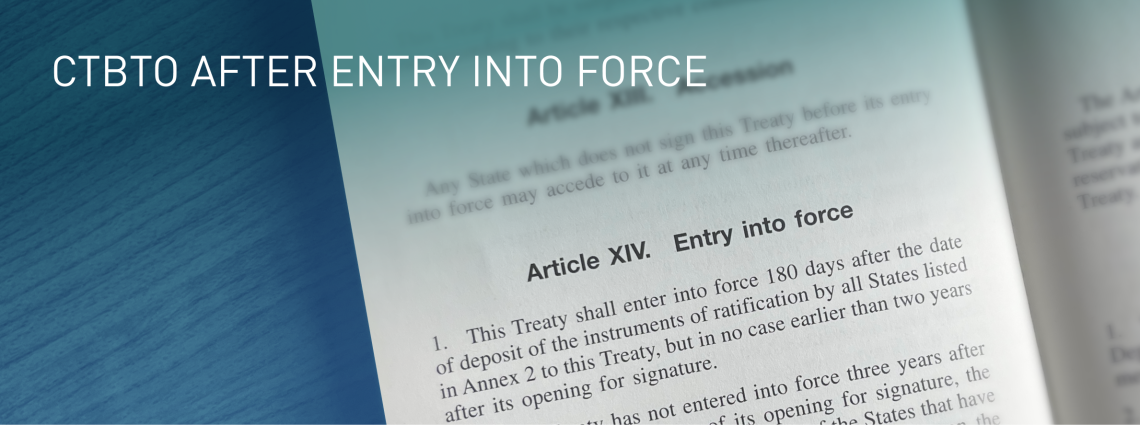CTBTO After Entry into Force
The Comprehensive Nuclear-Test-Ban Treaty (CTBT) will enter into force 180 days after the date of deposit of the instruments of ratification of all the 44 States listed in Annex 2. These 44 States participated in the negotiations of the Treaty in 1996 and possessed nuclear power or research reactors at the time.
Several developments will take place once the Treaty enters into force. Most importantly, it will be possible to use the CTBT verification regime for verification purposes according to the Treaty, including the ability to conduct on-site inspections.
There will also be organizational changes:
-
The Preparatory Commission will cease to exist and the Comprehensive Nuclear-Test-Ban Treaty Organization (CTBTO) will be established in its place.
-
Ratifying States will henceforth be known as States Parties.
-
The Provisional Technical Secretariat (PTS) will be replaced by a Technical Secretariat.
-
As well as the Technical Secretariat, two new CTBTO organs will be established: the Conference of the States Parties and the Executive Council.
-
The Executive Secretary will be replaced by a Director-General.
The seat of the CTBTO will remain in Vienna, Austria.
A Review Conference will be held every ten years after entry into force, to reassess the Treaty’s operation and effectiveness and to ascertain that its objectives and purposes are being upheld.
Assessed contributions from States Parties will be levied according to the same criteria, but non-payment may lead to loss of voting rights only if the arrears equal or exceed the amount of the contribution due from a country for the preceding two years, rather than after 365 days as is currently the case.
Conference of the States Parties
This will be the main organ of the future CTBTO, composed of the States Parties. Its first session will be convened not later than 30 days after the Treaty enters into force. After this initial meeting, it will convene regularly once a year, and may also hold special sessions at the discretion of the Conference or as requested by the Executive Council or a State Party supported by a majority of other States Parties.
The Conference will mainly consider issues related to the Treaty, as well as to the other organs of the CTBTO: namely, the Executive Council and the Technical Secretariat. It will have authority to make recommendations and decisions concerning the implementation of the Treaty, and will have the power to elect members to the Executive Council.
Each State Party in the Conference will have one vote and a simple majority of States Parties will constitute a quorum, i.e. the minimum number of members required to be present at a meeting to validate the proceedings.
Other duties of the Conference will include considering and adopting the report of the CTBTO on the implementation of the objectives of the Treaty, as well as its annual programme and budget. The Conference will also appoint the Director-General of the Technical Secretariat, on the recommendation of the Executive Council.
The Executive Council
The Executive Council will be the executive body, implementing the wishes of the CTBTO and accountable to the Conference of the States Parties. Each State Party will have the right to serve on the Executive Council, which will consist of 51 States Parties elected by the Conference, taking into account the goal of fair geographical distribution.
The Council will decide on procedural matters by a majority of all its members. On matters of substance, a two-thirds majority of all members will be needed on issues requiring a vote. If there is ambiguity on whether a matter is substantive, it will be presumed to be one of substance.
The main duties of the Executive Council include promoting the effective implementation of, and compliance with, the Treaty, and overseeing the affairs of the Technical Secretariat.
The Technical Secretariat
The Technical Secretariat will assist States Parties in carrying out the objectives of the Treaty, as well as aiding the Conference of the Parties and the Executive Council in their functions. It will be headed by a Director-General, appointed by the Conference on the recommendation of the Council.
It will be responsible for operating the International Data Centre (IDC), which will be an integral part of the Secretariat based at the CTBTO’s Vienna headquarters, and will supervise and coordinate the global International Monitoring System (IMS). In the case of a suspicious event, it may be called upon to conduct on-site inspections and report them to the Executive Council.
The Technical Secretariat will be tasked with developing manuals to oversee the operation of the verification regime, and will be responsible for administrative matters such as the draft programme and budget of the organization.
